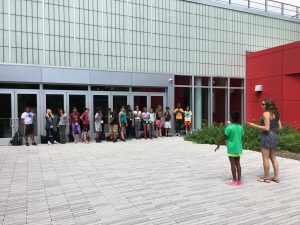FEATURES
The Rhythms of Sign Language
 Daniel Casasanto, a new member of the HD faculty, heads an NSF investigation of brain areas activated by hand movements when communicating through ASL.
Daniel Casasanto, a new member of the HD faculty, heads an NSF investigation of brain areas activated by hand movements when communicating through ASL.
Range of good feelings key to healthy aging
 In a new study led by Anthony Ong, people who experienced the widest range of positive emotions had the lowest levels of inflammation throughout their bodies.
In a new study led by Anthony Ong, people who experienced the widest range of positive emotions had the lowest levels of inflammation throughout their bodies.
NYC-based research finds interaction with kids is key
M arianella Casasola is working with Head Start Centers and day schools in New York City to promote development of spatial skills and language acquisition in preschoolers.
arianella Casasola is working with Head Start Centers and day schools in New York City to promote development of spatial skills and language acquisition in preschoolers.
Seeing eye expressions help us read the mental state of others
 New research by Adam Anderson reveals why the eyes offer a window into the soul.
New research by Adam Anderson reveals why the eyes offer a window into the soul.
STUDENTS IN THE NEWS
Simulation workshops teach youth about concussion risks
 Students in Valerie Reyna's Laboratory for Rational Decision Making welcome the Ithaca Youth Bureau's College Discovery Program for workshops on neuroscience and concussion risks.
Students in Valerie Reyna's Laboratory for Rational Decision Making welcome the Ithaca Youth Bureau's College Discovery Program for workshops on neuroscience and concussion risks.
The vegetarian identity - it's not just eating vegetables
 Daniel Rosenfeld '18 and his adviser Anthony Burrow, have developed a new way of thinking about what it is to be a vegetarian.
Daniel Rosenfeld '18 and his adviser Anthony Burrow, have developed a new way of thinking about what it is to be a vegetarian.
2017 CCE Summer Intern Elizabeth David: Child development in an outdoor classroom

Elizabeth Cavic '18 was a 2017 College of Human Ecology CCE Summer Intern working on the project "Enhancing Children’s Play and Parent’s Knowledge in Suffolk County" under the direction of Dr. Marianella Casasola. Read about her internship experience.
MULTIMEDIA
 NPR's Science Friday discusses risky decisions and the teenage brain
NPR's Science Friday discusses risky decisions and the teenage brain




